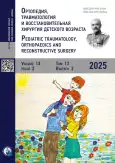A Photometric Method for Measuring Ankle Dorsiflexion Reproducibility in Young Athletes
- Authors: Gorobets L.V.1,2, Sapogovskiy A.V.1, Melchenko E.V.1, Kasev A.N.1,3, Kenis V.M.1
-
Affiliations:
- H. Turner National Medical Research Center for Сhildren’s Orthopedics and Trauma Surgery
- Medical Home
- Arkhangelsk Regional Children’s Clinical Hospital named after P.G. Vyzhletsov
- Issue: Vol 13, No 2 (2025)
- Pages: 154-160
- Section: Clinical studies
- URL: https://journal-vniispk.ru/turner/article/view/312535
- DOI: https://doi.org/10.17816/PTORS680803
- EDN: https://elibrary.ru/EWMSIW
- ID: 312535
Cite item
Abstract
BACKGROUND: Ankle dorsiflexion is one of the most important biomechanical indicators of the potential functional capacity of the foot. Its quantitative assessment is crucial in clinical evaluation, and in determining children’s readiness for sports and their potential risk of sports-related injuries.
AIM: This study aimed to evaluate the reproducibility of a photometric method for measuring ankle dorsiflexion angles in young athletes in relation to the conventional goniometric method.
METHODS: This study included 30 children aged 6–12 years who participated in regular sports activities and had not been diagnosed with orthopedic disorders. Dorsiflexion was measured by two independent specialists using goniometry and photometry based on anatomical landmarks. Inter-rater reliability was assessed using the intraclass correlation coefficient (ICC). The agreement between the methods was analyzed using Bland–Altman plots.
RESULTS: There were statistically significant differences (t-test: p = 0.04) in mean dorsiflexion angles between the goniometry measurement (17.15°) and the photometry measurement (18.1°). Photometry-based measurements exhibited higher inter-rater reliability (ICC = 0.91) than goniometry-based measurements (ICC = 0.78).
CONCLUSION: These findings indicate that the photometric method of measuring ankle dorsiflexion in children is a reliable and reproducible tool that can be recommended for practical use and monitoring for physically active children.
Keywords
Full Text
##article.viewOnOriginalSite##About the authors
Leonid V. Gorobets
H. Turner National Medical Research Center for Сhildren’s Orthopedics and Trauma Surgery; Medical Home
Email: gorobetsleonid@gmail.com
ORCID iD: 0000-0001-9424-3713
Russian Federation, Saint Petersburg; Rostov-on-Don
Andrey V. Sapogovskiy
H. Turner National Medical Research Center for Сhildren’s Orthopedics and Trauma Surgery
Email: sapogovskiy@gmail.com
ORCID iD: 0000-0002-5762-4477
SPIN-code: 2068-2102
MD, PhD, Cand. Sci. (Medicine)
Russian Federation, Saint PetersburgEvgenii V. Melchenko
H. Turner National Medical Research Center for Сhildren’s Orthopedics and Trauma Surgery
Email: emelchenko@gmail.com
ORCID iD: 0000-0003-1139-5573
SPIN-code: 1552-8550
MD, PhD, Cand. Sci. (Medicine)
Russian Federation, Saint PetersburgAleksandr N. Kasev
H. Turner National Medical Research Center for Сhildren’s Orthopedics and Trauma Surgery; Arkhangelsk Regional Children’s Clinical Hospital named after P.G. Vyzhletsov
Email: an.kasev@aodkb29.ru
ORCID iD: 0009-0006-0802-4949
SPIN-code: 6193-3610
Russian Federation, Saint Petersburg; Arkhangelsk
Vladimir M. Kenis
H. Turner National Medical Research Center for Сhildren’s Orthopedics and Trauma Surgery
Author for correspondence.
Email: kenis@mail.ru
ORCID iD: 0000-0002-7651-8485
SPIN-code: 5597-8832
MD, PhD, Dr. Sci. (Medicine), Professor
Russian Federation, Saint PetersburgReferences
- Kirby KA. Biomechanics of the normal and abnormal foot. J Am Podiatr Med Assoc. 2000;90(1):30–34. doi: 10.7547/87507315-90-1-30
- Postnikova A, Potekhina Y, Kurnikova A, et al. Features of joint mobility in skiers and skaters. Human. Sport. Medicine. 2019;19(1):29–35. doi: 10.14529/hsm190104 EDN: ZEHZDN
- Dimitrieva AY, Kenis VM, Klychkova IY, et al. Results of the first Russian Delphi survey on the diagnosis and treatment of flatfoot in children. Pediatric Traumatology, Orthopaedics and Reconstructive Surgery. 2023;11(1):49–66. doi: 10.17816/PTORS112465 EDN: CAHOCE
- Belyakova AM, Sereda AP, Samoilov AS. Experience of rehabilitation the athletes after surgical intervention on the Achilles tendon. Clinical Practice. 2017;8(2):72–80. doi: 10.17816/clinpract8272-80 EDN: YLYKNV
- Santos LLL, Generoso TO, Angeli LRA, et al. Idiopathic toe walking: What’s new? An integrative review. J Foot Ankle. 2024;18(1):21–30. doi: 10.30795/jfootankle.2024.v18.1764 EDN: VVTIJC
- Cerrillo-Sanchis J, Ricart-Luna B, Rodrigo-Mallorca D, et al. Relationship between ankle dorsiflexion range of motion and sprinting and jumping ability in young athletes. J Bodyw Mov Ther. 2024;39:43–49. doi: 10.1016/j.jbmt.2024.02.013 EDN: HEPNXO
- Repetyuk AD, Achkasov EE, Sereda AP, et al. Evaluation of indicators of goniometry of the ankle joint in the complex rehabilitation of athletes with peroneal tendinopathy. Sports Medicine: Science and Practice. 2022;12(2):40–45. doi: 10.47529/2223-2524.2022.2.4 EDN: DTNFSX
- Conley KA, Geist K, Shaw JN, et al. The effect of goniometric alignment on passive ankle dorsiflexion range of motion among patients following ankle arthrodesis or arthroplasty. Foot Ankle Spec. 2012;5(3):175–179. doi: 10.1177/1938640012444731
- Johansen M, Haslund-Thomsen H, Kristensen J, Skou ST. Photo-based range-of-motion measurement: reliability and concurrent validity in children with cerebral palsy. Pediatr Phys Ther. 2020;32(2):151–160. doi: 10.1097/PEP.0000000000000689 EDN: JXQRPO
- Blonna D, Zarkadas PC, Fitzsimmons JS, O’Driscoll SW. Validation of a photography-based goniometry method for measuring joint range of motion. J Shoulder Elbow Surg. 2012;21(1):29–35. doi: 10.1016/j.jse.2011.06.018
- Russo RR, Burn MB, Ismaily SK, et al. Is digital photography an accurate and precise method for measuring range of motion of the shoulder and elbow? J Orthop Sci. 2018;23(2):310–315. doi: 10.1016/j.jos.2017.11.016
- Verhaegen F, Ganseman Y, Arnout N, et al. Are clinical photographs appropriate to determine the maximal range of motion of the knee? Acta Orthop Belg. 2010;76(6):794–798.
- Rome K. Ankle joint dorsiflexion measurement studies. A review of the literature. J Am Podiatr Med Assoc. 1996;86(5):205–211. doi: 10.7547/87507315-86-5-205
- Gatt A, Chockalingam N. Clinical assessment of ankle joint dorsiflexion: a review of measurement techniques. J Am Podiatr Med Assoc. 2011;101(1):59–69. doi: 10.7547/1010059
- Konor MM, Morton S, Eckerson JM, Grindstaff TL. Reliability of three measures of ankle dorsiflexion range of motion. Int J Sports Phys Ther. 2012;7(3):279–287.
- Rastogi A, Agarwal A. Long-term outcomes of the Ponseti method for treatment of clubfoot: a systematic review. Int Orthop. 2021;45(10):2599–2608. doi: 10.1007/s00264-021-05189-w EDN: KOUPEB
- Almansoof HS, Nuhmani S, Muaidi Q. Role of ankle dorsiflexion in sports performance and injury risk: A narrative review. Electron J Gen Med. 2023;20(5):em521. doi: 10.29333/ejgm/13412 EDN: XWMUNY
Supplementary files









